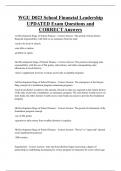WGU D023 School Financial Leadership
UPDATED Exam Questions and
CORRECT Answers
1st Development Stage of School Finance - Correct Answer- The period of local district
financial responsibility, with little or no assistance from the state
-used to be local or church
-rate bills or tuition
-problem in equity
2nd Development Stage of School Finance - Correct Answer- The period of emerging state
responsibility, with the use of flat grants, subventions, and other nonequalizing state
allocations to local districts
-state to supplement local tax revenues to provide acceptable programs
3rd Development Stage of School Finance - Correct Answer- The emergence of the Strayer-
Haig concept of a foundation program (minimum program)
-Each local district would levy the amount of local tax that was required in the richest district
of the state to provide a foundation, or minimum, program. The rich district would receive no
state funds; the other districts would receive state funds necessary to provide the foundation
program.
4th Development Stage of School Finance - Correct Answer- The period of refinement of the
foundation program concept
-use of flat grants
-question to take money from wealthy districts to equalize
5th Development Stage of School Finance - Correct Answer- "Power" or "open-end" (shared
costs) equalization practices
-20th century
Equalization - Correct Answer- state and local districts began exercising a degree of
partnership in establishing and paying for a basic program of education for every school-age
,child in the state—at least in theory. In practice, the link between funding and program
quality was questionable.
open-ended, or shared-cost, equalization plan - Correct Answer- the percentage of this
program to be paid by each individual district and by the state. This percentage of state funds
would be high for poor districts and low for wealthier ones. Once that determination has been
made for each district, the same partnership ratio would be maintained to pay the total cost of
the school program in each district
-Harlan Updegraff
6th Development Stage of School Finance - Correct Answer- The shift of emphasis and
influence, and funding for special need
-economic factors influenced (wars, terrorist attacks, natural disasters, fluctuating prices in
energy, had to rethink budget and safety of schools
7th Development Stage of School Finance - Correct Answer- A focus on adequacy in
education finance
-court cases
-sufficient funding is needed to meet state laws, standards, and requirements, and must be
constitutionally enforceable
-CCSS
Foundational funding - Correct Answer- The state provides a minimal level of funding as a
guarantee per student expenditure. The intent of this system is to counteract the disparity of
wealth across various districts of a state.
Common School Era - Correct Answer- Local school districts were formed to support the
education of the local population, many of whom were the children of immigrants. In order to
accommodate this influx of educational need with limited personal resources, local property
taxes became mandated to support public schools.
Early Colonial Schooling - Correct Answer- Funded through tuition or rate changes,
primarily as a funding of the local community or church of that community.
Funding for public schools is directly addressed in which document? - Correct Answer- State
Constitution
, -The funding and operation of public schools is directly addressed in each state's constitution.
Access to education and the quality are different depending upon how the state defines its
language. For example, a "right" to education is different than a "goal" to educate all citizens.
A "right" provides grounds for equity and equality litigation while a "goal" may provide more
flexibility in disparity.
What is meant by pupil expenditure? - Correct Answer- The pupil expenditure is the total
expense accounted for by that specific student. For example, this funding amount includes
but is not limited to: personnel expenses (salary, benefits, and other human resource
expenses), transportation costs (gas, busses, oil, personnel), facility expenses (building
construction, maintenance, utilities, insurance), and instructional resources (books, supplies,
technology, materials). The amount of this pupil expenditure will vary as the cost of living
changes for the location, but in many states the "foundational per pupil expenditure" is a
guaranteed amount per pupil. In instances where the local funding is insufficient, it is
supplemented by the state.
Financial disparity - Correct Answer-
Financial adequacy - Correct Answer-
Financial productivity - Correct Answer-
Federal Funding - Correct Answer- Federal aid continues to be provided in the form of
categorical aid. Yet, it may be time for a larger federal role in financing schools. The largest
and most visible categorical federal assistance programs are ESEA and IDEA. Also, Raced to
the Top has garnered federal aid as a key initiative in the Obama administration. Federal
lands have provided funds for localities in the form of payments in lieu of taxes.
State Funding - Correct Answer- Equalization aid is the chief method states use to distribute
funding to local school districts within their borders using a foundation program or district
power equalization
Local Funding - Correct Answer- property taxes
ESEA/ESSA through funding - Correct Answer- Title 1, Part A, of the ESEA, reauthorized in
2001, (often called the No Child Left Behind Act) authorizes federal aid to disadvantaged and
low-income children for supplementary education and related services.




